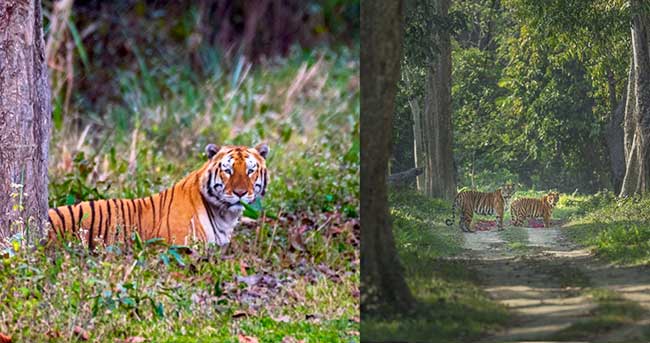Though there are eight Project Tiger reserves in three northeast India states -- Assam, Arunachal Pradesh and Mizoram, wildlife experts have mixed opinions about their further development and upkeep of the tigers.
Of the eight Project Tiger reserves, Assam has four reserves -- Manas National Park, Orang National Park, Pakke Tiger Reserve and Kaziranga National Park; Arunachal Pradesh has three -- Kamlang Tiger Reserve, Namdapha Tiger Reserve, Pakke Tiger Reserve; Mizoram has the Dampa Tiger Reserve.
Arunachal Pradesh's Namdapha Tiger Reserve is the oldest in the northeastern region which was notified in 1987 under the Wildlife (Protection) Act, 1972.
The Dampa Tiger Reserve does not have a single tiger now while according to the 2018 census, Assam has 190 tigers while 29 are in Arunachal Pradesh.
Northeast India's bio-diversity conservation and research organisation �Aaranyak' secretary general Dr Bibhab Kumar Talukdar said that the tiger being India's national animal, it has the attention of government and non-government agencies working to secure the future of tigers in India.
"Project Tiger launched in April 1973 with the declaration of the tiger as India's national animal has been playing a leading role to safeguard tigers and their habitats in India.
"Efforts put in the past 50 years in India indeed resulted in the protection of tigers and their habitats that not only benefited tigers, but also other associated species in the tiger reserves," Talukdar told IANS.
He said that Aaranyak has been complementing the efforts of the government agencies and initiated camera trapping of tigers in Manas National Park in Assam way back in 2005 when most people thought that Manas may not have any tigers due to the prolonged socio-political turmoil in that landscape.
According to Talukdar, the camera traps set up by Aaranyak in association with the Manas National Park authorities in 2005 found a few tigers, giving renewed hope for tigers' recovery in the Manas Tiger Reserve.
Head of Tiger Research and Conservation Division of Aaranyak, Dr M. Firoz Ahmed said that the tiger reserves in northeast India are important conservation sites for human well-being and not just for tigers.
However, local communities are increasingly wary about the tiger reserves due to poor communication as well as restrictions on them, Ahmed told IANS.
He said that the current model needs a relook to ensure that the communities are partners with the tiger reserves rather than sufferers.
"Such changes are likely to ensure community ownership, support, increase the tiger population and at the same time benefit the ecology, people and biodiversity," Ahmed said.
A tiger reserve is not only about the tiger but also has a variety of flora and fauna ranging from small insects to big mammal species.
The Kamlang Tiger Reserve in Arunachal Pradesh is a forested area which has high species richness.
As there has been no official documentation of the species inhabiting the reserve, Cheshta Singh, field director and divisional forest officer of the Kamlang Tiger Reserve, took the initiative to monitor the biodiversity of the reserve and record the different species.
The compiled report titled, �Kamlang Tiger Reserve: At a glance', has comprehensively documented the species including 33 mammals, 37 birds, 4 snakes, 79 butterflies, two dragonflies, one spider species and four floral species.
Forest officials in Itanagar said that the Union Environment, Forest and Climate Change Ministry would soon notify the Dibang Tiger Reserve in Arunachal Pradesh.
Once notified, the Dibang Tiger Reserve would be India's first high altitude tiger reserve and the largest in terms of area, at 4149 sq km, the officials said.
The tiger estimation study in 2018 revealed the presence of two adult tigers in the Dibang Wildlife Sanctuary, which has international borders on three sides and is crisscrossed by several rivers and rivulets.
It is nestled in the eastern Himalaya biodiversity hotspot.
Though there is no tiger in the Dampa Tiger Reserve in Mizoram, it is home to sloth bears, serows, hoolock gibbons, slow loris, the endangered Phayre's leaf monkeys, Indian leopards, clouded leopards among others.
Dampa Tiger Reserve in western Mizoram, covering an approximately 500 sq km area in the Lushai Hills, was declared a tiger reserve under the Project Tiger initiative in 1994.
Before 1994, Dampa was a wildlife sanctuary.
Environment expert Apurba Kumar Dey said that the forest cover has been declining in all the eight states of the northeastern region due to various illegal activities, including coal mining, traditional 'Jhum' farming (slash and burn method of cultivation), ganja (marijuana) cultivation and poppy plantations.
"Sometimes, the extremist outfits also get involved in the unlawful coal mining for money. There is a big nexus between a section of politicians, officials, mafia, traders in different northeastern states", he said.
"The declining forest cover in the region has affected the habitations of the wildlife specially tigers and elephants," Dey told IANS.








‘Pahalgam incident deeply disturbing & tragic’: Former Pakistan PM Imran Khan
Former Pakistan Prime Minister Imran Khan on Tuesday termed the Pahalgam terror attack as disturbing & tragic and also condoled the victims and their families.
Congress finally deletes 'Gayab' post targeting PM Modi after outrage
Under fire from the BJP over its social media post targeting Prime Minister Narendra Modi, Congress finally, on Tuesday, took down the controversial post.
Guterres calls EAM Jaishankar, Pak PM Sharif; stresses pursuing justice in Pahalgam terror attack
Secretary-General Antonio Guterres stressed the importance of pursuing justice in the Pahalgam terrorist attack while speaking with External Affairs Minister (EAM) S Jaishankar and Pakistan’s Prime Minister Muhammad Shebaz Sharif, his Spokesperson Stephane Dujarric said on Tuesday.
Congress organises ‘Save Constitution’ rallies across NE states
The opposition Congress has been organising ‘Samvidhan Bachao’ (Save Constitution) campaign in the northeastern states. Claiming that the Constitution is in danger under the BJP-led Central government, the opposition Congress held a massive rally in Agartala on Tuesday.
RSS chief Bhagwat meets PM Modi after security huddle: Signs of a hard-hitting response in the works
In a significant political development, RSS chief Mohan Bhagwat met Prime Minister Narendra Modi at his official residence at 7, Lok Kalyan Marg on Tuesday evening.
What PM Modi's free hand to armed forces against terror means for cross-border action?
Prime Minister Narendra Modi’s unambiguous message during a high-level security meeting - ‘India is determined to deliver a crushing blow to terrorism’ - marks more than just a strong statement of resolve.
Justice BR Gavai appointed as next Chief Justice of India
Justice Gavai was elevated as a Judge of the Supreme Court on May 29, 2019. Appointed as Additional Judge of the Bombay High Court in November 2003, he became a permanent Judge in November 2005.
Three more Bangladeshi nationals held in Tripura
The Tripura Frontier of the Border Security Force (BSF) on Tuesday apprehended three Bangladeshi nationals, including a woman, for illegally entering India, officials said.